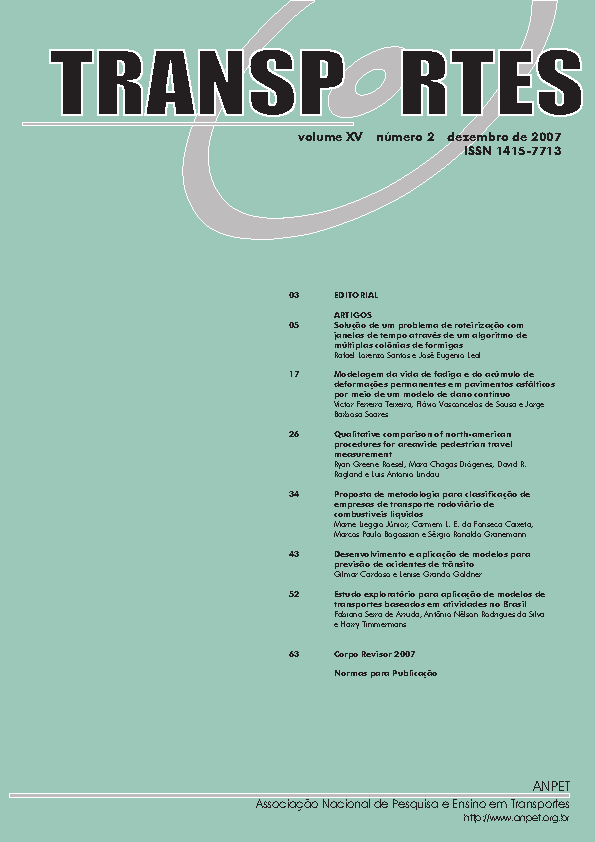Qualitative comparison of north-american procedures for areawide pedestrian travel measurement
DOI:
https://doi.org/10.14295/transportes.v15i2.33Resumo
There is no standard system for estimating area-wide pedestrian volumes in the United States. As a result, pedestrian volumes cannot be routinely used to guide transportation investments and monitoring measures performance. Vehicle volumes, by contrast, are measured systematically in each state and are reported to the Federal Highway Administration annually to be used in the allocation of federal funds. This paper investigates the advantages and disadvantages of three approaches to the creation of a standard system of pedestrian volume measurement: direct sampling, survey methods, and modeling. Examples of each method are given, and the potential of each to become a national standard is discussed. Of the three approaches, the modeling methods were judged to be most suitable for tracking pedestrian volumes at the national, state, and sub-state level. A standardized pedestrian volume modeling method could make use of existing data sources without generating the need for a new national pedestrian data collection effort.
Downloads
Downloads
Publicado
Como Citar
Edição
Seção
Licença
Ao submeter um manuscrito para publicação neste periódico, todos os seus autores concordam, antecipada e irrestritamente, com os seguintes termos:
- Os autores mantém os direitos autorais e concedem à Revista TRANSPORTES o direito de primeira publicação do manuscrito, sem nenhum ônus financeiro, e abrem mão de qualquer outra remuneração pela sua publicação pela ANPET.
- Ao ser submetido à Revista TRANSPORTES, o manuscrito fica automaticamente licenciado sob a Licença Creative Commons Attribution, que permite o compartilhamento do trabalho com reconhecimento da autoria e da publicação inicial neste periódico.
- Os autores têm autorização para assumir contratos adicionais separadamente, para distribuição não exclusiva da versão do trabalho publicada neste periódico (ex.: publicar em repositório institucional ou como capítulo de livro), com reconhecimento da publicação inicial nesta revista, desde que tal contrato não implique num endosso do conteúdo do manuscrito ou do novo veículo pela ANPET.
- Os autores têm permissão e são estimulados a publicar e distribuir seu trabalho online (ex.: em repositórios institucionais ou na sua página pessoal) depois de concluído o processo editorial. Como a Revista TRANSPORTES é de acesso livre, os autores são estimulados a usar links para o site da Revista TRANSPORTES nesses casos.
- Os autores garantem ter obtido a devida autorização dos seus empregadores para a transferência dos direitos nos termos deste acordo, caso esses empregadores possuam algum direito autoral sobre o manuscrito. Além disso, os autores assumem toda e qualquer responsabilidade sobre possíveis infrações ao direito autoral desses empregadores, isentando a ANPET e a Revista TRANSPORTES de toda e qualquer responsabilidade neste sentido.
- Os autores assumem toda responsabilidade sobre o conteúdo do trabalho, incluindo as devidas e necessárias autorizações para divulgação de dados coletados e resultados obtidos, isentando a ANPET e a Revista TRANSPORTES de toda e qualquer responsabilidade neste sentido.









